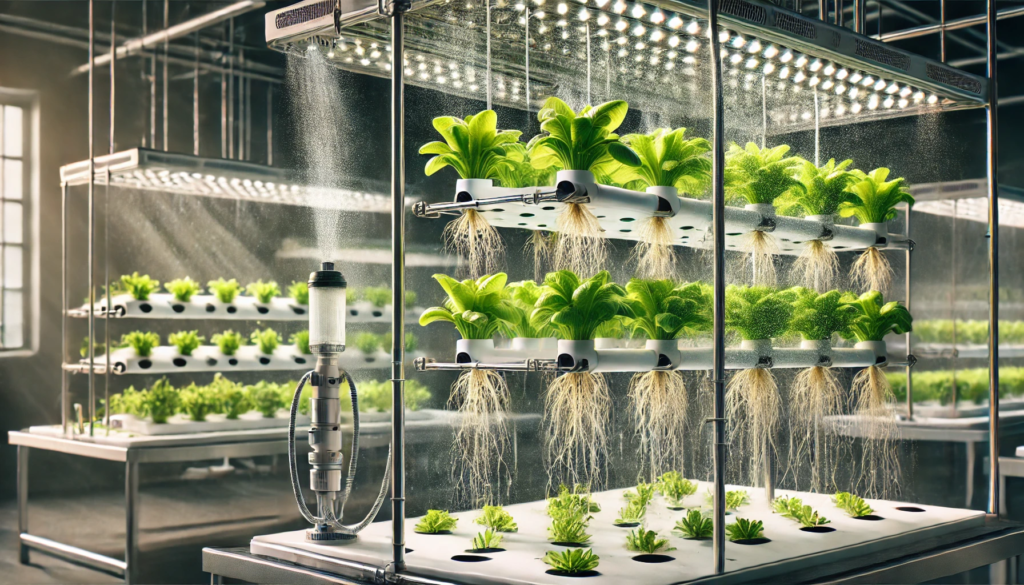Aeroponics is a cutting-edge method of growing plants without the use of soil. Unlike traditional farming or even hydroponic systems, where plants are grown in water, aeroponics relies on air and a fine mist of nutrient-rich water to nourish the plants. This soil-free approach offers significant advantages in terms of efficiency, water usage, and growth speed. Understanding how aeroponic systems work and learning how to set up your own can help you take full advantage of this innovative agricultural technology.
What Is an Aeroponic System?
An aeroponic system is a type of plant-growing technology where the roots of the plants are suspended in the air and misted with a nutrient solution. The lack of soil or growing medium allows for direct access to oxygen, which encourages faster and healthier plant growth. Aeroponics is particularly useful for indoor gardening and controlled-environment agriculture, where factors like light, temperature, and humidity can be closely monitored.
Plants grown in aeroponic systems are suspended on trays or in towers with their roots exposed below. Instead of absorbing water and nutrients through soil or water baths, the plants receive them through regular misting from spray nozzles. The fine mist of nutrient solution is delivered directly to the roots, ensuring that the plants get exactly what they need without the risk of waterlogging or nutrient imbalances.
How Does Aeroponics Work?
The primary concept behind aeroponics is delivering the right amount of nutrients, water, and oxygen directly to the plant’s roots. This is achieved by using misters or nozzles that spray a nutrient-rich solution in intervals, ensuring that the plant roots remain hydrated and fed while allowing oxygen to reach them.
Key Components of an Aeroponic System
- Growing Chamber: This is where the plants are placed, with their roots hanging freely in the air. The growing chamber is typically enclosed to protect the roots from light, which could harm them. A closed environment also helps maintain humidity levels, which are critical for root health.
- Misting System: The misting system consists of pumps and spray nozzles that deliver a fine mist of nutrient solution to the roots. The system is designed to operate in timed intervals, providing moisture and nutrients while preventing the roots from drying out.
- Nutrient Reservoir: This reservoir holds the nutrient solution, a water-based mixture containing all the essential minerals and nutrients that plants need to grow. The solution is pumped from the reservoir to the misting nozzles in the growing chamber.
- Water Pump: A pump ensures that the nutrient solution is continuously circulated from the reservoir to the misting system. The pump is an essential component for maintaining the regular misting cycles that keep the plants hydrated and nourished.
- Timer and Control System: Most aeroponic systems are equipped with a timer or control system that regulates the misting intervals. This ensures that the plants receive mist at the optimal times, preventing overwatering or underfeeding.
- Support Structure: Aeroponic systems often use racks, towers, or trays to hold the plants in place while allowing their roots to dangle freely. The support structure can vary depending on the design of the system and the types of plants being grown.
Benefits of Aeroponic Systems
Aeroponic systems offer a range of benefits compared to traditional soil-based farming or other forms of hydroponics:
1. Increased Growth Rates
Aeroponics promotes faster plant growth due to the increased oxygen available to the roots. The lack of a growing medium means that the roots are exposed directly to the air, allowing for better oxygen uptake. Combined with the efficient delivery of nutrients, plants in aeroponic systems tend to grow faster and larger than those in traditional systems.
2. Water Efficiency
Aeroponic systems use significantly less water than traditional soil-based farming or even hydroponic systems. Since the roots are misted rather than submerged, there is minimal water wastage. Any excess water can be captured and recirculated, making aeroponics one of the most water-efficient growing methods available.
3. Nutrient Control
In an aeroponic system, you have complete control over the nutrient solution that is delivered to the plants. This allows for precise adjustments to the nutrient levels, ensuring that plants get exactly what they need at different stages of growth. Nutrient imbalances are rare, and the risk of nutrient runoff into the environment is minimized.
4. Space Efficiency
Aeroponic systems are ideal for urban farming and indoor gardening because they require less space than traditional farming methods. Plants can be grown vertically, stacked in towers, or arranged in compact configurations. This makes aeroponics a popular choice for environments where space is limited.
5. Fewer Pests and Diseases
Since aeroponic systems don’t use soil, many of the pests and diseases associated with soil-borne pathogens are eliminated. The enclosed nature of the system also reduces the risk of contamination. This means healthier plants and less reliance on pesticides or herbicides.
Types of Aeroponic Systems
There are several types of aeroponic systems, each suited to different scales of operation and plant types. Here are some of the most common:
1. Low-Pressure Aeroponics
Low-pressure aeroponics is the simplest form of the system and is often used in small-scale or home setups. The system uses basic pumps and nozzles to mist the plant roots at regular intervals. While less sophisticated than high-pressure systems, low-pressure aeroponics is affordable and effective for growing a variety of plants.
2. High-Pressure Aeroponics
High-pressure aeroponics involves the use of more advanced equipment to deliver a fine mist of nutrient solution to the roots. The mist particles are smaller in high-pressure systems, allowing for better absorption by the plant roots. High-pressure aeroponics is typically used in commercial applications due to its higher cost and complexity, but it offers superior growth rates and efficiency.
3. Fogponics
Fogponics is a variation of aeroponics where the nutrient solution is delivered in the form of an ultra-fine fog. The smaller particle size allows for even more efficient nutrient absorption by the roots. Fogponics is often used for delicate plants or seedlings, as it provides a gentle delivery of nutrients.
Setting Up an Aeroponic System
Setting up an aeroponic system can seem daunting, but with the right components and a clear plan, it can be a straightforward process. Here’s a step-by-step guide to getting started:
Step 1: Choose a Location
Choose a location for your aeroponic system that has access to power and water. If growing indoors, ensure that the area is well-ventilated and has room for the system’s structure. Consider placing the system near windows for natural light, or set up grow lights if necessary.
Step 2: Gather Materials
You will need the following materials to set up your aeroponic system:
- Growing chamber or container to hold plants
- Misting nozzles and water pump
- Nutrient reservoir
- Timer or control system
- Nutrient solution
- Support structure for the plants (trays, towers, etc.)
- Optional: Grow lights if setting up indoors without sufficient natural light
Step 3: Set Up the Growing Chamber
Install the growing chamber, making sure it’s secure and has space for the plants to grow with their roots hanging freely. Set up the support structure that will hold the plants in place while their roots are exposed to the mist.
Step 4: Install the Misting System
Position the misting nozzles inside the growing chamber, ensuring that they are placed to evenly mist all the roots. Connect the nozzles to the water pump, which will draw the nutrient solution from the reservoir. The pump should be connected to a timer that regulates the misting intervals.
Step 5: Prepare the Nutrient Solution
Mix the nutrient solution according to the specific needs of the plants you are growing. Fill the reservoir with the solution, ensuring that it is correctly diluted and balanced for optimal growth.
Step 6: Test the System
Before adding plants, run the system to ensure that the misters are working correctly, the pump is functioning, and the nutrient solution is circulating properly. Adjust the misting intervals as needed to avoid over- or under-watering the roots.
Step 7: Add Plants
Once the system is functioning properly, you can add your plants. Place them into the support structure, ensuring that their roots hang freely in the growing chamber. Turn on the misting system and let the aeroponics take care of the rest!
Conclusion
Aeroponic systems offer an efficient, sustainable, and highly productive way to grow plants in a soil-free environment. By delivering nutrients, water, and oxygen directly to the roots, aeroponics maximizes plant growth while minimizing resource use. Whether you’re a home gardener looking to experiment with new technology or a commercial grower seeking to increase yield, aeroponics provides a versatile and innovative solution.
FAQs
What plants grow best in aeroponic systems?
Leafy greens, herbs, and vine plants like tomatoes, lettuce, basil, and strawberries thrive in aeroponic systems. However, many types of plants can be grown using aeroponics with the proper care and environment.
How often should I mist plants in an aeroponic system?
Misting intervals depend on the specific system and plant type. Typically, plants should be misted every few minutes to maintain proper hydration without over-saturating the roots.
What is the difference between aeroponics and hydroponics?
Aeroponics uses air and mist to deliver nutrients to the plants, while hydroponics involves growing plants in water. Aeroponics allows for more oxygen exposure to the roots, which can enhance growth rates.
Can aeroponic systems be used outdoors?
Yes, aeroponic systems can be used outdoors as long as the environmental conditions are favorable for the plants. However, indoor setups offer more control over factors like temperature, humidity, and light.
How much space do I need for an aeroponic system?
Aeroponic systems can be adapted for various space requirements. Vertical systems are particularly space-efficient, making them ideal for small indoor environments or urban gardening.
Is it difficult to maintain an aeroponic system?
Once set up, aeroponic systems are relatively low-maintenance. The key tasks include regularly checking the nutrient solution, maintaining the misting system, and ensuring that plants are healthy and growing properly.



